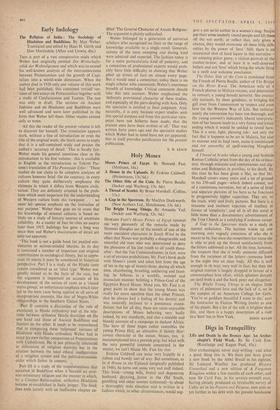Digs in Tranquillity
Life and Death in the Bronze Age: An Archae- ologist's Field Work. By Sir Cyril Fox. (Routledge and Kegan Paul, 45s.) OLD archaeologists never stop writing—and what a good thing this is. We have just been given a new book by the Abbe Breuil in his eighties, Sir Leonard Woolley has produced History Unearthed and a new edition of A Forgotten Kingdom within a few months of each other, and now Sir Cyril Fox, in his seventy-seventh year, having already produced an invaluable survey of Celtic art in his Pattern and Purpose, now puts us yet further in his debt with the present handsome
volume. It is a survey of Bronze Age burials in England and Wales between 1700 and 700 ac, and is mainly an account of the author's own field work and a commentary on burial practices arising naturally out of the discussion of his. ex- cavations.
Fox dug his first Bronze Age barrow in 1922 in collaboration with Earl Cawdor; it was the Beacon Hill, Barton Mills, barrow in Suffolk. He removed the mound completely and discovered,
t among other things, fourteen secondary burials. While he now considers the complete removal of a barrow 'unnecessary for a fully trained in- vestigator,' he records that for him the Barton M ills complete excavation was invaluable train-
ing. In this total excavation he was going back to the techniques developed by General Pitt- Rivers between 1880 and 1900, and he recognises that Pit t-Rivers's techniques were 'largely neglected and mostly forgotten in the 1920s.' Fox, by his work at Beacon Hill and in -Wales, and Wheeler, by his excavations in the Twenties, re- created British excavational technique and brought it back to the high standards that inspired Pitt-Rivers.
In 1924 Fox became Keeper of Archaeology in the National Museum of Wales—the Director was then Sir Mortimer Wheeler; and in 1927 he suc- ceeded Wheeler as Director, a post which he held until his retirement in 1948. He did not permit the Public cares of his directorship to interfere with his excavation and research, and this book is largely a record of digs in Wales during the quarter- century Fox was at Cardiff.
These excavations have all been published before. Here Fox recollects them in tranquillity and tries again to see what lay behind the archte- °logical evidence he so faithfully recorded, to see What ritual and belief is implied in the material traces—the trenches, pits, the trodden ground, the charcoal dust; in fact, to bring life into this record of Bronze Age death—'for it is the acts of living men and women that we archaeologists write up,' he declares.
One of the most endearing features of Fox as a man and an archaeologist has been his infectious enthusiasm, and it is impossible to spend more than five minutes in his company without realis- ing how much he loves the past as well as his fellow men. In his preface he makes no secret of this love of survey and excavation. 'In this field work I took great pleasure,' he says, 'I like measuring and plotting complex structures as their pattern gradually develops; I like the iso- lation of a thinly populated countryside to which such work usually takes the archaeologist, and the friendly contact with a couple of countrymen such as one employs for the heavy work.'
Can we not have more of this confession of faith? Sir Leonard Woolley has given us Spade- work, Sir Mortimer Wheeler Still Digging, and O. G. S. Crawford Said and Done. Sir Cyril Fox's autobiography is surely well overdue. The success of Pattern and Purpose and the present book should encourage him for a moment to look at his own past in the twentieth century AD. Old archaeologists of his unusual distinction and charm, and with his facility for clear and con- vincing exposition, must just not be allowed to



































 Previous page
Previous page